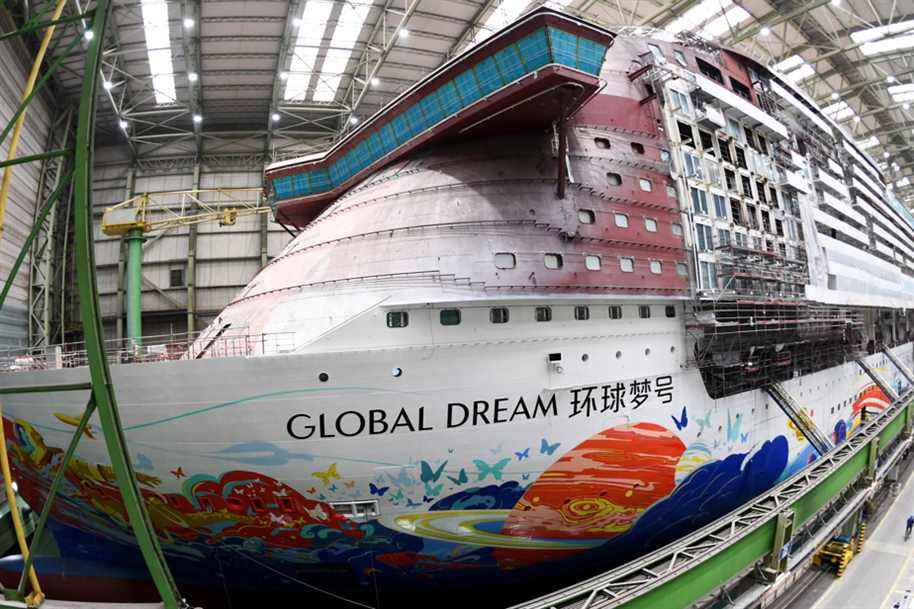(Wismar) One of the largest cruise ships in the world waits, unfinished, in a windswept shed. It will never see the sea if the shipyards of Wismar, emblem of northern Germany, do not find a buyer.
Updated yesterday at 6:30 p.m.
“We are classic victims of COVID-19,” laments Carsten Haake, CEO of MV Werften shipyards, which filed for bankruptcy in early January.
Consequence: the construction of the Global Dreama juggernaut that is to become the first ship in the world that can accommodate more than 10,000 passengers and crew, has been brought to a halt.
And the whole port city on the shores of the Baltic is wondering what its future will hold.
The fate of the company was played out thousands of kilometers away, in Asia, in the offices of the company Genting HK, which simultaneously owns four shipyards in Germany, including that of Wismar, and the company of “Dream Cruises” cruise, for whom the boat was intended.
Specializing in casinos and travel, the group went bankrupt, overwhelmed by the impact of the pandemic and abandoned by its parent company, the Malaysian Genting.
The German state, due to a lack of guarantees, cut public aid.
Since then, the large white liner, 342 meters long – a little longer than the Eiffel Tower -, decorated with colorful drawings of astronauts and mermaids, has been hoping for a savior.
The project, at a total cost estimated at 1.5 billion euros (2.17 billion Canadian dollars), is “75% complete”, according to management, but needs 600 million euros ($ 870 million CAD) to continue.
Uncertainty is growing among the 2,000 employees of the MV Werften shipyards in the cities of Stralsund, Rostock and Wismar, all located in Western Pomerania, a former East German region.
Countdown
A judicial administrator, Christoph Morgen has been appointed. Its mission: to find a buyer and, above all, “a new client” for the Global Dream.
But the liner was designed in a context of crazy growth for the cruise sector, brutally halted by the pandemic.
Now, even if “investors have expressed their interest”, according to Christoph Morgen, finding a buyer at a good price for such a giant seems difficult, while the health crisis is not over.
The countdown is on: the administrator only has until 1er March to find a workable solution.
The situation is being carefully observed by the local authorities, for whom the bankruptcy was a “shock, as in the whole of the city”, because “many families are dependent on this factory, generations have worked there”, affirms the Social Democratic (SPD) mayor of Wismar, Thomas Beyer, told AFP.
The shipyards are closely linked to the history of the city: built after the Second World War, they were first intended to repair the boats of the Soviet Red Army, before diversifying in the 1950s.
The fall of the Berlin Wall and the collapse of East German industry, too uncompetitive for a liberalized economy, led to massive layoffs.
Privatized in the early 90s, they then saw a succession of ten owners, German and international, but survived the upheavals. Until the COVID-19 pandemic.
“Not Wismar”
On the central square of Wismar, lined with small colorful buildings typical of Hanseatic cities, Heike Reimann, 67, worries about the possible disappearance of an emblematic activity.
“Wismar, without its shipyard, it’s not Wismar”, deplores this resident whose husband, Siegfried, worked for ten years in the company.
If no maritime buyer wants to invest, it will be necessary to resolve to convert the site into “off-shore wind power”, or “hydrogen”, two industries of the future for the ecological transition, observes Mr. Morgen.
A perspective that interests some residents: “Is it still wise to build such big boats, with global warming? “Asks Christian Bünger, 63, crossed on the port.
But this option would be a social disaster, according to the unions.
“For a different project, you will need employees with different qualifications,” says Henning Groskreutz, trade unionist IG Metall.
At the town hall, we also refuse this scenario. “We must keep our maritime industry, it sticks to our skin,” says Thomas Beyer.
